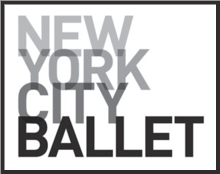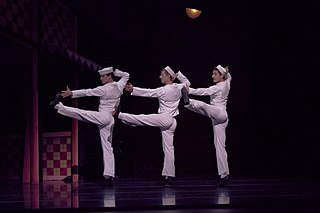
New York City Ballet (NYCB) is a ballet company founded in 1948 by choreographer George Balanchine and Lincoln Kirstein. Balanchine and Jerome Robbins are considered the founding choreographers of the company. Léon Barzin was the company's first music director. City Ballet grew out of earlier troupes: the Producing Company of the School of American Ballet, 1934; the American Ballet, 1935, and Ballet Caravan, 1936, which merged into American Ballet Caravan, 1941; and directly from the Ballet Society, 1946.

Jerome Robbins was an American dancer, choreographer, film director, theatre director and producer who worked in classical ballet, on stage, film, and television.
The American Ballet was the first professional ballet company George Balanchine created in the United States. The company was founded with the help of Lincoln Kirstein and Edward Warburg, managed by Alexander Merovitch and populated by students of Kirstein and Balanchine's School of American Ballet. Having failed to mount a tour, American Ballet began performing at the Old Met. After being allowed to stage only two dance performances in 1936 and an evening of dances choreographed to the music of Igor Stravinsky in 1937), Balanchine moved the company to Hollywood in 1938. The company was restarted as the American Ballet Caravan and toured North and South America, although it too folded after several years.
Le Baiser de la fée is a neoclassical ballet in one act and four scenes composed by Igor Stravinsky in 1928 and revised in 1950 for George Balanchine and the New York City Ballet. Based on Hans Christian Andersen's short story Isjomfruen, the work is an homage to Pyotr Ilyich Tchaikovsky, for the 35th anniversary of the composer's death. Stravinsky elaborated several melodies from early piano pieces and songs by Tchaikovsky in his score. A commission by Ida Rubinstein from 1927, the ballet was choreographed by Bronislava Nijinska and premiered in Paris on 27 November 1928.
Carolyn George was an American ballerina, photographer, and dance instructor.

Christopher Peter Wheeldon is an English international choreographer of contemporary ballet.

Apollo is a neoclassical ballet in two tableaux composed between 1927 and 1928 by Igor Stravinsky. It was choreographed in 1928 by twenty-four-year-old George Balanchine, with the composer contributing the libretto. The scenery and costumes were designed by André Bauchant, with new costumes by Coco Chanel in 1929. The scenery was executed by Alexander Shervashidze, with costumes under the direction of Mme. A. Youkine. The American patron of the arts Elizabeth Sprague Coolidge had commissioned the ballet in 1927 for a festival of contemporary music to be held the following year at the Library of Congress in Washington, D.C.

Miami City Ballet is an American ballet company based in Miami Beach, Florida, led by artistic director Lourdes Lopez.
John Taras was an American ballet master, repetiteur, and choreographer.
Tango is a ballet made by New York City Ballet co-founder and founding choreographer George Balanchine to Stravinsky's Tango (1940) arranged 1953 by the composer. The premiere took place June 10, 1982, as part of City Ballet's Stravinsky Centennial Celebration at the New York State Theater, Lincoln Center.
Rachel Rutherford is a former soloist with New York City Ballet.

Fancy Free is a ballet composed in 1944 by Leonard Bernstein. The Ballet Theatre premiered the ballet with choreography by Jerome Robbins, scenery by Oliver Smith, costumes by Kermit Love, and lighting by Ronald Bates. The premiere took place on Tuesday, 18 April 1944 at the old Metropolitan Opera House, New York. The New York City Ballet premiere took place on Thursday, 31 January 1980. Fancy Free provided the basis for the later musical, On the Town. A portion of the score was also used in the opening scenes of Alfred Hitchcock's Rear Window.
Lewellyn Farr Christensen was a ballet dancer, choreographer and director for many companies. He was largely associated with George Balanchine and the San Francisco Ballet, which he directed from 1952–1984. Other companies Christensen was a part of include Ballet Caravan, directed by Lincoln Kirstein, and Ballet Society, directed by Kirstein and Balanchine.
Bugaku is a ballet made by New York City Ballet co-founder and ballet master George Balanchine to eponymous music by Toshiro Mayuzumi, commissioned by City Ballet in 1962. The premiere took place on 30 March 1963 at City Center of Music and Drama, New York, with scenery by David Hays, costumes by Karinska, and lighting by Ronald Bates. NYCB had toured Japan in 1958 and the Gagaku Company of the Imperial Household toured the US the following year.
The Chairman Dances is a ballet made by New York City Ballet ballet master in chief Peter Martins to John Adams' eponymous music from 1985. The music was originally written for Adams' opera, Nixon in China, but not used in production: the scene is that in which Mao Zedong dances with his future bride, movie star Chiang Ch'ing. The premiere took place on 14 May 1988, as part of City Ballet's American Music Festival at New York State Theater, Lincoln Center, with scenery and costumes by Rouben Ter-Arutunian, and lighting by Mark Stanley.
Interplay is a ballet in one act made by Jerome Robbins, subsequently ballet master of New York City Ballet, for Billy Rose's Concert Varieties to Morton Gould's 1945 American Concertette. The premiere took place on Friday, 1 June 1945 at the Ziegfeld Theatre, New York. It was taken into the repertory of the American Ballet Theatre and presented on Wednesday, 17 October that year with costumes by Irene Sharaff. It has been revived for the City Ballet on Tuesday, 23 December 1952 at City Center of Music and Drama.
Union Jack is a ballet made by New York City Ballet co-founder and founding choreographer George Balanchine to traditional British tunes, hornpipe melodies and music-hall songs, ca. 1890–1914, adapted by Hershy Kay. The premiere took place on 13 May 1976, at the New York State Theater, Lincoln Center, to honor British heritage in the United States its bicentennial with costumes by Rouben Ter-Arutunian, original lighting by Ronald Bates and current lighting by Mark Stanley. At the finale the ensemble spells out "God Save the Queen" in semaphore code and the Union Jack unfurls. Principal dancer Jock Soto included an excerpt from Union Jack in his farewell performance in June 2005.
Chaconne is a ballet made by New York City Ballet co-founder and ballet master George Balanchine to ballet music from Gluck's Orfeo ed Euridice. The premiere took place Wednesday, 22 January 1976 at the New York State Theater, Lincoln Center, with lighting by Ronald Bates; Robert Irving conducted. Chaconne was danced in practice clothes at its premiere; Karinska's costumes were added in the spring season.
The Gershwin Piano Concerto is a ballet made on New York City Ballet by its ballet master Jerome Robbins to George Gershwin's 1925 Concerto in F. The premiere took place on February 6, 1982 at the New York State Theater, Lincoln Center, N.Y.
Divertimento No. 15 is a ballet choreographed by George Balanchine to Mozart's eponymous music. The ballet was made for the New York City Ballet. Balanchine first choreographed the score in 1952, for a ballet titled Caracole. In 1956, he planned to revive Caracole for a celebration of Mozart's bicentenary but made a new ballet to the same music instead. Divertimento No. 15 premiered on May 31, 1956, at the American Shakespeare Theatre, Stratford, Connecticut.